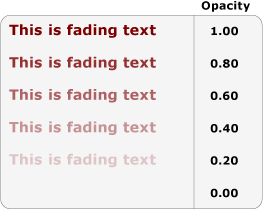Comment : appliquer des animations à du texte
Les animations peuvent modifier l’affichage et l’apparence du texte dans votre application. Les exemples suivants utilisent différents types d’animations pour affecter l’affichage du texte dans un TextBlock contrôle.
Exemple
L’exemple suivant utilise un DoubleAnimation pour animer la largeur du bloc de texte. La valeur de largeur change pour passer de la largeur du bloc de texte à 0 sur une durée de 10 secondes, puis les valeurs de largeur sont inversées et la procédure continue. Ce type d’animation crée un effet de balayage.
<TextBlock
Name="MyWipedText"
Margin="20"
Width="480" Height="100" FontSize="48" FontWeight="Bold" Foreground="Maroon">
This is wiped text
<!-- Animates the text block's width. -->
<TextBlock.Triggers>
<EventTrigger RoutedEvent="TextBlock.Loaded">
<BeginStoryboard>
<Storyboard>
<DoubleAnimation
Storyboard.TargetName="MyWipedText"
Storyboard.TargetProperty="(TextBlock.Width)"
To="0.0" Duration="0:0:10"
AutoReverse="True" RepeatBehavior="Forever" />
</Storyboard>
</BeginStoryboard>
</EventTrigger>
</TextBlock.Triggers>
</TextBlock>
L’exemple suivant utilise un DoubleAnimation pour animer l’opacité du bloc de texte. La valeur d’opacité passe de 1.0 à 0 sur une durée de 5 secondes, puis les valeurs d’opacité sont inversées et la procédure continue.
<TextBlock
Name="MyFadingText"
Margin="20"
Width="640" Height="100" FontSize="48" FontWeight="Bold" Foreground="Maroon">
This is fading text
<!-- Animates the text block's opacity. -->
<TextBlock.Triggers>
<EventTrigger RoutedEvent="TextBlock.Loaded">
<BeginStoryboard>
<Storyboard>
<DoubleAnimation
Storyboard.TargetName="MyFadingText"
Storyboard.TargetProperty="(TextBlock.Opacity)"
From="1.0" To="0.0" Duration="0:0:5"
AutoReverse="True" RepeatBehavior="Forever" />
</Storyboard>
</BeginStoryboard>
</EventTrigger>
</TextBlock.Triggers>
</TextBlock>
Le diagramme suivant montre l’effet du TextBlock contrôle qui modifie son opacité pendant 0.001.00 l’intervalle de 5 secondes défini par le Duration.

L’exemple suivant utilise un ColorAnimation pour animer la couleur de premier plan du bloc de texte. La valeur de la couleur de premier plan passe d’une couleur à une autre sur une durée de 5 secondes, puis les valeurs de couleur sont inversées et la procédure continue.
<TextBlock
Name="MyChangingColorText"
Margin="20"
Width="640" Height="100" FontSize="48" FontWeight="Bold">
This is changing color text
<TextBlock.Foreground>
<SolidColorBrush x:Name="MySolidColorBrush" Color="Maroon" />
</TextBlock.Foreground>
<!-- Animates the text block's color. -->
<TextBlock.Triggers>
<EventTrigger RoutedEvent="TextBlock.Loaded">
<BeginStoryboard>
<Storyboard>
<ColorAnimation
Storyboard.TargetName="MySolidColorBrush"
Storyboard.TargetProperty="Color"
From="DarkOrange" To="SteelBlue" Duration="0:0:5"
AutoReverse="True" RepeatBehavior="Forever" />
</Storyboard>
</BeginStoryboard>
</EventTrigger>
</TextBlock.Triggers>
</TextBlock>
L’exemple suivant utilise un DoubleAnimation pour faire pivoter le bloc de texte. Le bloc de texte effectue une rotation complète sur une durée de 20 secondes, puis la procédure de rotation se répète.
<TextBlock
Name="MyRotatingText"
Margin="20"
Width="640" Height="100" FontSize="48" FontWeight="Bold" Foreground="Teal"
>
This is rotating text
<TextBlock.RenderTransform>
<RotateTransform x:Name="MyRotateTransform" Angle="0" CenterX="230" CenterY="25"/>
</TextBlock.RenderTransform>
<!-- Animates the text block's rotation. -->
<TextBlock.Triggers>
<EventTrigger RoutedEvent="TextBlock.Loaded">
<BeginStoryboard>
<Storyboard>
<DoubleAnimation
Storyboard.TargetName="MyRotateTransform"
Storyboard.TargetProperty="(RotateTransform.Angle)"
From="0.0" To="360" Duration="0:0:10"
RepeatBehavior="Forever" />
</Storyboard>
</BeginStoryboard>
</EventTrigger>
</TextBlock.Triggers>
</TextBlock>
Voir aussi
.NET Desktop feedback
